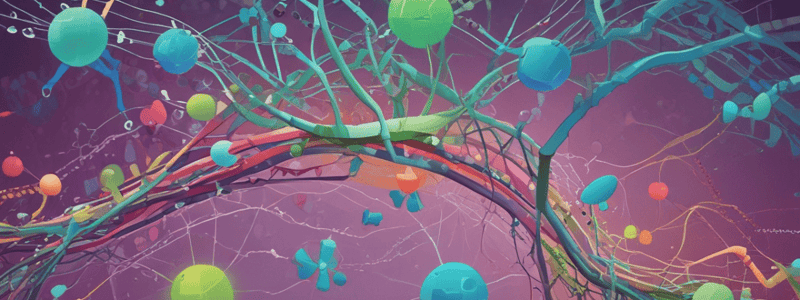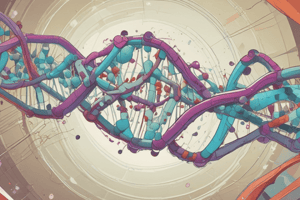Podcast
Questions and Answers
What is the primary function of primary databases?
What is the primary function of primary databases?
- To provide curated data to normal users
- To store analyzed results of primary data
- To archive experimental results submitted by scientists (correct)
- To apply computational algorithms to primary data
Which of the following is NOT an example of a primary database?
Which of the following is NOT an example of a primary database?
- InterPro (correct)
- PDB
- GenBank
- Metacyc
What is the purpose of accession numbers in primary databases?
What is the purpose of accession numbers in primary databases?
- To identify data uniquely and allow retrieval (correct)
- To apply computational algorithms to primary data
- To provide curated data to normal users
- To store analyzed results of primary data
What type of data is stored in secondary databases?
What type of data is stored in secondary databases?
Which of the following polymerases is isolated from Pyrococcus furiosus?
Which of the following polymerases is isolated from Pyrococcus furiosus?
What is the difference between primary and secondary databases?
What is the difference between primary and secondary databases?
Which database has both primary and secondary characteristics?
Which database has both primary and secondary characteristics?
What is the purpose of secondary databases?
What is the purpose of secondary databases?
What type of data is highly curated in secondary databases?
What type of data is highly curated in secondary databases?
Which of the following is an example of a secondary database?
Which of the following is an example of a secondary database?
What is the primary source of data for primary databases?
What is the primary source of data for primary databases?
What is a unique identifier assigned to each data entry in primary databases?
What is a unique identifier assigned to each data entry in primary databases?
Which type of database contains genome sequence data?
Which type of database contains genome sequence data?
What is the purpose of applying computational algorithms to primary databases?
What is the purpose of applying computational algorithms to primary databases?
Which database contains protein sequence and functional information?
Which database contains protein sequence and functional information?
What is the characteristic of data in primary databases?
What is the characteristic of data in primary databases?
What is the advantage of secondary databases over primary databases?
What is the advantage of secondary databases over primary databases?
Which protein database contains motifs and domains?
Which protein database contains motifs and domains?
What is the characteristic of data in secondary databases?
What is the characteristic of data in secondary databases?
Which type of database accepts primary sequences derived from peptide sequencing experiments?
Which type of database accepts primary sequences derived from peptide sequencing experiments?
Study Notes
Types of Polymerase
- Pfu polymerase is isolated from Pyrococcus furiosus
- Tli polymerase is isolated from Thermococcus litoralis
Gel Electrophoresis
- No information available in the provided text
Introduction to Bioinformatics
- No information available in the provided text
Types of Biological Databases
Primary Databases
- Also known as archival databases
- Contain experimentally derived data like genome sequence and macromolecular structure
- Data is not curated or modified
- Data is uniquely identified with an accession number that never changes
- Examples: GenBank, DDBJ, PDB, SwissProt, PIR, TrEMBL, Metacyc
Secondary Databases
- Contain analyzed results from primary databases
- Data is highly curated and processed
- Contain more valuable knowledge compared to primary databases
- Examples: InterPro, UniProt Knowledgebase
Hybrid Databases
- Some databases have both primary and secondary characteristics
- Example: UniProt accepts primary sequences derived from peptide sequencing experiments
Types of Polymerase
- Pfu polymerase is isolated from Pyrococcus furiosus
- Tli polymerase is isolated from Thermococcus litoralis
Gel Electrophoresis
- No information available in the provided text
Introduction to Bioinformatics
- No information available in the provided text
Types of Biological Databases
Primary Databases
- Also known as archival databases
- Contain experimentally derived data like genome sequence and macromolecular structure
- Data is not curated or modified
- Data is uniquely identified with an accession number that never changes
- Examples: GenBank, DDBJ, PDB, SwissProt, PIR, TrEMBL, Metacyc
Secondary Databases
- Contain analyzed results from primary databases
- Data is highly curated and processed
- Contain more valuable knowledge compared to primary databases
- Examples: InterPro, UniProt Knowledgebase
Hybrid Databases
- Some databases have both primary and secondary characteristics
- Example: UniProt accepts primary sequences derived from peptide sequencing experiments
Studying That Suits You
Use AI to generate personalized quizzes and flashcards to suit your learning preferences.
Related Documents
Description
Quiz covering topics in molecular biology and bioinformatics, including types of polymerases, gel electrophoresis, and biological databases.




